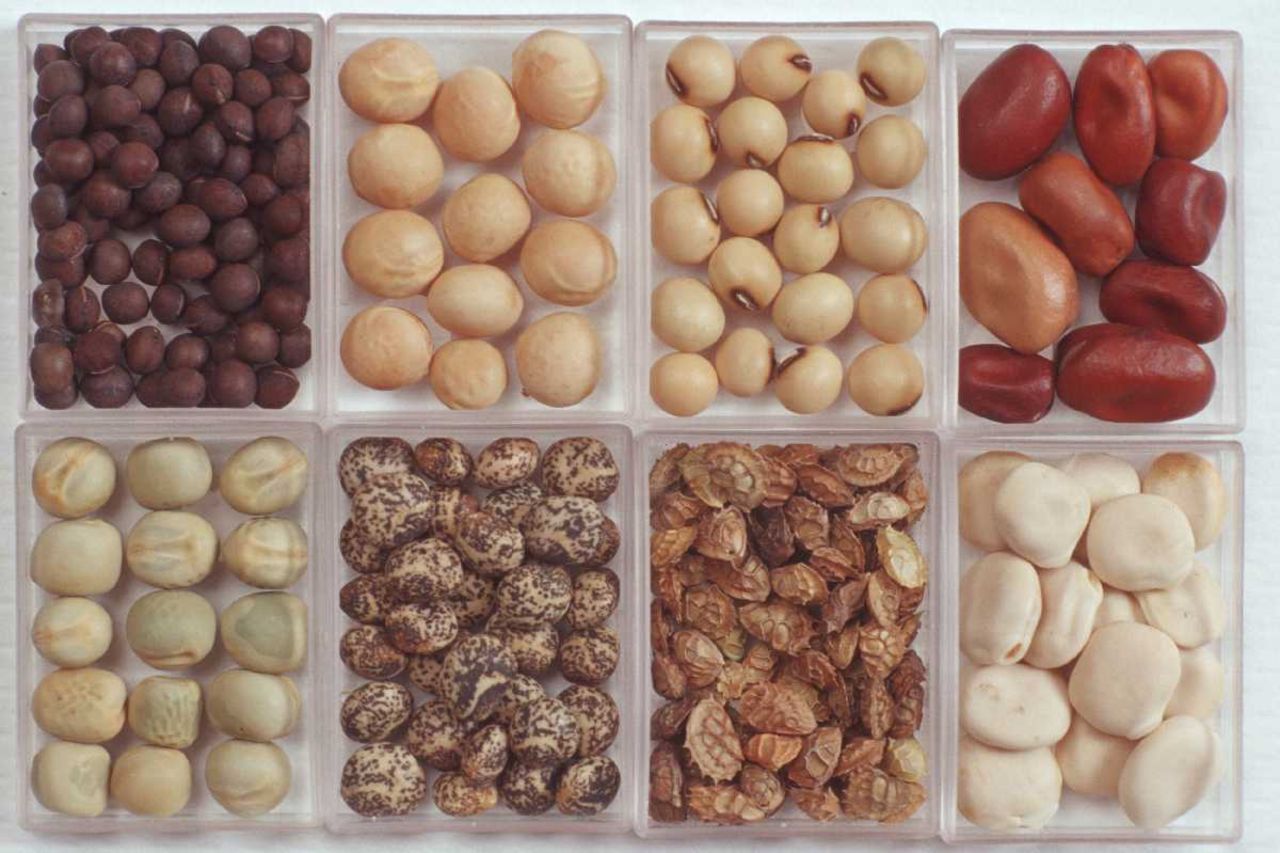Project
Evaluation of organic feedstuffs

Analytical data for evaluation of organic feedstuffs in monogaster nutrition: main ingredients, amino acids and vitamins
In the near future, organic farmers should feed all of their animals with 100 % organically produced feedstuffs. Consequently, the relevance of the protein supply from domestic feedstuffs for monogastric animals, like poultry and swine, is going to be further increased.
Background and Objective
Knowledge of the contents of valuable ingredients, in particular the specific contents of essential amino acids, in different feed batches would improve ration formulation in organic farming. The precaecal digestibility of the crude protein and the amino acids is also of interest in monogastric animal feeding. Moreover, the supply of vitamins must meet the needs of the animals. Therefore, it is important to evaluate the native vitamin contents in organic feedstuffs. Unfortunately, they are not yet properly considered and there are no current table values for vitamin contents in organic feedstuffs.
The aim of our project was therefore to quickly determine the content of selected ingredients in locally produced organic feedstuffs in order to have knowledge of the feed value immediately after harvesting and before ration formulation. These values can then be used to optimise feed rations. Furthermore, we aimed to develop an in vitro method to quickly determine the precaecal digestibility of crude protein and amino acids for broilers in the laboratory. Another aim of the project was to create a database of the native contents of the B-vitamins thiamine and riboflavin in organic feedstuffs.
To gain analysis results quickly and cheaply, near-infrared spectroscopy (NIRS) was the method of choice. We wanted to create calibrations for selected ingredients in grain legumes (peas, field beans, blue lupins) and cereal grains (wheat, barley, rye, triticale, oats). The analysis data of all components can be used to optimise rations for all monogastric animals.
Approach
Harvest samples of the most important domestic feedstuffs (grain legumes and cereals) were collected from variety trials of the chambers of agriculture, the national research institutes at different locations in Germany, and at the Institute of Organic Farming in Trenthorst. We analysed these samples with classical methods and recorded NIR spectra. The crude nutrients were analysed according to the methods of the VDLUFA. HPLC was used for the determination of amino acids and vitamins. The NIR spectra were taken in the range of 1000 to 2500 nm. Two thirds of each of the samples served for the calibration, one third for the validation of methods. Estimates were calculated for each crude nutrient, each amino acid, and each vitamin. We assessed the quality of the calibration on the basis of statistical standards to evaluate the accuracy of the estimates.
Results
Stable NIRS calibrations (56 in total) for crude nutrients (15) and amino acids (41) that are of interest in diet formulation were developed. These calibrations enable a quick and cost-effective analysis.
Strong variations of the contents of all tested ingredients and of the in vitro digestibility of crude protein and amino acids in cereals and grain legumes were observed. These variations can be a result of differences between varieties and of environmental influences during crop cultivation. The study confirmed that differences between batches of a feedstuff strongly influence the composition of the diet. Especially when few components are used, it is necessary to know their composition. Since fluctuations in the crude nutrient and amino acid composition must be taken into account when designing the ration, it is recommended to analyse the crude nutrient composition of each batch of a feedstuff. Thus, the use of table values cannot be recommended. However, NIRS is a valuable tool for predicting the content of many ingredients.
The in vitro method proved promising for estimating the precaecal crude protein and amino acid digestibility. However, further combined in vitro and in vivo studies are necessary to be able to make relevant statements for different feedstuffs.
Thünen-Contact

Involved Thünen-Partners
Funding Body
-
Federal Ministry of Food und Agriculture (BMEL)
(national, öffentlich)
Duration
3.2012 - 3.2019
More Information
Project funding number: 11OE054
Funding program: Bundesprogramm Ökologischer Landbau und andere Formen nachhaltiger Landwirtschaft (BÖLN)
Project status:
finished
Publications
- 0
Witten S, Aulrich K (2022) Concept note: in vitro multi-enzyme approach to estimate crude protein and amino acid digestibility in grains for broilers. Organic Agric 12(2):259-266, DOI:10.1007/s13165-022-00388-0
- 1
Witten S, Böhm H, Aulrich K (2020) Effect of variety and environment on the contents of crude nutrients and amino acids in organically produced cereal and legume grains. Organic Agric 10:199-219, DOI:10.1007/s13165-019-00261-7
- 2
Witten S, Ritteser C, Grashorn MA, Aulrich K (2019) Application of an in vitro multi-enzyme assay to estimate the precaecal digestibility of crude protein and amino acids in broiler chicken. Proc Soc Nutr Physiol 28: 91
- 3
Witten S, Aulrich K (2019) Exemplary calculations of native thiamine (vitamin B1) and riboflavin (vitamin B2) contents in common cereal-based diets for monogastric animals. Organic Agric 9(2):155–164, DOI:10.1007/s13165-018-0219-9
- 4
Witten S, Grashorn M, Aulrich K (2019) Faba beans (Vicia faba L.) and field peas (Pisum sativum L.) as feedstuffs for broiler chicken: precaecal protein and amino acid digestibility. In: Third International Legume Society Conference ILS3 2019 : Legumes for human and planet health ; Book of abstracts, Poznan 2019. p 48
- 5
Witten S, Aulrich K (2019) In vitro Rohproteinverdaulichkeit ökologisch erzeugter Ackerbohnen und Futtererbsen für Broiler. In: Mühlrath D, Albrecht J, Finckh M, Hamm U, Heß J, Knierim U, Möller D (eds) Innovatives Denken für eine nachhaltige Land- und Ernährungswirtschaft : Beiträge zur 15. Wissenschaftstagung Ökologischer Landbau ; Kassel, 5. bis 8. März 2019. Berlin: Köster, pp 310-311
- 6
Witten S, Grashorn MA, Aulrich K (2019) Praecaecale Rohprotein- und Aminosäurenverdaulichkeit einer Öko-Ackerbohne und einer Öko-Futtererbse bei jungen Broilern. In: Mühlrath D, Albrecht J, Finckh M, Hamm U, Heß J, Knierim U, Möller D (eds) Innovatives Denken für eine nachhaltige Land- und Ernährungswirtschaft : Beiträge zur 15. Wissenschaftstagung Ökologischer Landbau ; Kassel, 5. bis 8. März 2019. Berlin: Köster, pp 316-317
- 7
Witten S, Aulrich K (2019) Was ist drin? : optimale Rationen aus eigener Ernte. Bio Land(7):40-41
- 8
Witten S, Aulrich K (2018) Effect of variety and environment on the amount of thiamine and riboflavin in cereals and grain legumes. Anim Feed Sci Technol 238:39-46, DOI:10.1016/j.anifeedsci.2018.01.022
- 9
Witten S, Aulrich K (2018) Investigations on the amounts of crude protein and amino acids of organically cultivated winter cereals (wheat, rye, and triticale). Proc Soc Nutr Physiol 27:51
- 10
Witten S, Aulrich K (2018) Investigations on thiamine contents of organically produced cereals and grain legumes for poultry diets. Proc Soc Nutr Physiol 27:133
- 11
Witten S, Grashorn M, Aulrich K (2018) Precaecal digestibility of crude protein and amino acids of a field bean (Vicia faba L.) and a field pea (Pisum sativum L.) variety for broilers. Anim Feed Sci Technol 243:35-40, DOI:10.1016/j.anifeedsci.2018.07.001
- 12
Witten S, Aulrich K (2017) Investigations on vitamin B2 and B6 contents in organically produced cereal and grain legume varieties. Proc Soc Nutr Physiol 26:136
- 13
Witten S, Tripke N, Mattiesch L, Aulrich K (2017) Qualität von Eigenmischungen in der Schweinefütterung - eignet sich die Nahinfrarotspektroskopie zur Bewertung? In: Wolfrum S, Heuwinkel H, Reents HJ, Hülsbergen KJ (eds) Ökologischen Landbau weiterdenken - Verantwortung übernehmen, Vertrauen stärken : Beiträge zur 14. Wissenschaftstagung Ökologischer Landbau, Freising-Weihenstephan, 7. bis 10. März 2017. Berlin: Köster, pp 592-593
- 14
Witten S, Aulrich K (2017) Untersuchungen zu B-Vitaminen in Getreide und Körnerleguminosen aus ökologischem Anbau. In: Wolfrum S, Heuwinkel H, Reents HJ, Hülsbergen KJ (eds) Ökologischen Landbau weiterdenken - Verantwortung übernehmen, Vertrauen stärken : Beiträge zur 14. Wissenschaftstagung Ökologischer Landbau, Freising-Weihenstephan, 7. bis 10. März 2017. Berlin: Köster, pp 772-774
- 15
Witten S, Aulrich K, Böhm H (2016) Effect of sulfur fertilization and variety on yield and contents of crude protein and amino acids of organically produced blue lupins (Lupinus angustifoliusL.). In: Legumes for a Sustainable World : ILS2 ; Second International Legume Society Conference ; 11th - 14th October 2016 ; Troia Resort, Portugal ; Book of Abstracts. Lisboa: Universidade Nova, p 254
- 16
Witten S, Böhm H, Aulrich K (2015) Beziehungen zwischen Rohprotein- und Aminosäuregehalten in ökologisch erzeugten Ackerbohnen (Vicia faba L.). In: Häring AM, Hörning B, Hoffmann-Bahnsen R, Luley H (eds) Beiträge zur 13. Wissenschaftstagung Ökologischer Landbau "Am Mut hängt der Erfolg: Rückblicke und Ausblicke auf die ökologische Landbewirtschaftung". pp 307-308
- 17
Witten S, Böhm H, Aulrich K (2015) Effect of variety and environment on the contents of crude nutrients, lysine, methionine and cysteine in organically produced field peas (Pisum sativum L.) and field beans (Vicia faba L.). Landbauforsch Appl Agric Forestry Res 65(3/4):205-216, DOI:10.3220/LBF1447765843000
- 18
Witten S, Böhm H, Aulrich K (2015) Einflüsse auf die Zusammensetzung wertgebender Inhaltsstoffe ökologisch erzeugter Futtererbsen (Pisum sativum L.). In: Häring AM, Hörning B, Hoffmann-Bahnsen R, Luley H (eds) Beiträge zur 13. Wissenschaftstagung Ökologischer Landbau "Am Mut hängt der Erfolg: Rückblicke und Ausblicke auf die ökologische Landbewirtschaftung". pp 68-71
- 19
Bellof G, Aulrich K (2013) Körnerleguminosen in der Fütterung. KTBL Heft 100:36-41
- 20
Aulrich K, Böhm H (2012) Quality of organic legumes - prediction of main ingredients and amino acids by Near-Infrared Spectroscopy. Landbauforsch SH 362:401-403

![[Translate to English:] [Translate to English:]](/media/_processed_/8/e/csm_Bildschirmfoto_2021-03-03_bearb_fc48ac88bf.jpeg)
![[Translate to English:] [Translate to English:]](/media/_processed_/8/e/csm_Bildschirmfoto_2021-03-03_bearb_ba3ec0e9d7.jpeg)
![[Translate to English:] Logo des Bundesministerium für Ernährung und Landwirtschaft](/media/allgemein/logos/BMEL_Logo.svg)